By Joseph D’Aleo
The super El Nino of 1982/83 which coincided with world-wide weather extremes sparked significant research into the global atmospheric effects of this phenomenon. When strong correlations were found, a whole new era of long range climate forecasting began. Over the past decade, our understanding of ENSO and other climate factors or teleconnections has grown and extended and enabled skillful seasonal (and I might argue decadal) forecasting.
Before the winter in October, we used the sun, ENSO and QBO (among other factors) to identify analog years (circled). We picked 1961/62, 1964/64 as the best analogs with 1985/86 also within window of expected solar and ENSO conditions.
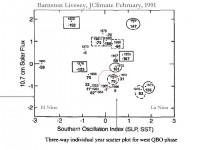
They suggested another cold north central winter

The actual temperatures generally were in line with those analogs, especially across the North Central. It was warmer in the southern Rockies and plains where it was dry. The cold in the northeast was concentrated in January.

Compare that to the CPC forecast from last October which in the absence of a clear ENSO state used trends as their tool. This despite the fact they have done a lot of the good research most private forecasters use. Their forecasts have a warm bias, the politically correct position. They were better in the southern plains but missed the northern plains cold as they did last year.
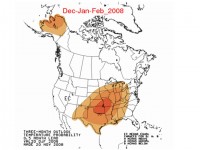
They are at it again for next winter.
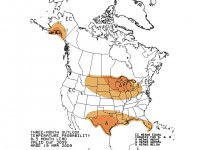
Trends can be useful tool during the times when you are entrenched in a particular regime but can lead to bad forecasts when a new regime develops (like selling at the lows of a bear market or buying at the peak of a bull market). The trend they used was the trend during the recent warm PDO, warm AMO, active solar decades of the 1980s and 1990s. Now with the PDO in its cold mode, the AMO turned negative and the sun in a superlong slumber, the trends should be and have been reversing both globally and regionally. Good luck CPC. You will need it. See pdf here.
By Ara C. Trembly
In a move that could spark the biggest waste of time and money since the federal government’s $787 billion stimu-pork package, the National Association of Insurance Commissioners (NAIC) is requiring insurance companies to disclose “the financial risks they face from climate change, as well as actions the companies are taking to respond to those risks.”
“Climate change will have huge impacts on the insurance industry and we need better information on how insurers are responding to the challenge,” says Pennsylvania Insurance Commissioner Joel Ario, who chairs the NAIC Climate Change and Global Warming Task Force.
And just what are those impacts? According to climate change proponents, major increases in the Earth’s temperature and carbon dioxide levels will result in such disasters as major cities being flooded by rising oceans due to catastrophic arctic ice melting. There are also projected negative impacts on the planet’s food supply and poverty level from fires, floods and droughts. For awhile, they were also saying that it would also mean more hurricanes-and thus more property damage - but that seems to have been debunked by recent statements from the National Oceanic and Atmospheric Administration (NOAA) and others in the scientific community.
All this fear is based on computer models created by climatologists and other interested parties, and computers - as we all know - never make mistakes. Unfortunately, the people who put the information into computers and then interpret results are prone to make mistakes-driven, perhaps, by greed or political correctness.
Then there are those in the media who want to bring you and me the most exciting and entertaining stories possible. These media gleefully told us of dangerous melting ice packs in Greenland and Antarctica that would precipitously raise sea levels. According to Climate of Extremes, a new (2009) book from the Cato Institute, however, the latest actual measurements “indicate an extremely small contribution of Greenland and Antarctica to sea-level rise, with little evidence for any marked change in the past decade.’ In reference to Antarctica, the authors state that “it definitely hasn’t warmed up down there,” adding that temperatures in Greenland were “warmer for decades in the early 20th Century, and for millennia after the end of the last ice age” with no apparent catastrophic effect.
But what about the fact that the Earth’s temperature is rising? The Climate of Extremes authors don’t take issue with that idea, but they do emphasize that both the rate of increase and the resulting fear are overblown. While the infamous Intergovernmental Panel on Climate Change (IPCC) predicts a 2.5 to 10.4 degree (F) temperature rise from 1990 to 2100, the authors point out that the actual observed rate of warming is very close to the lowest end of the IPCC range. The predicted rate of warming, they observe, is clearly higher than the observed rate.
As to the role of carbon dioxide as a primary climate change culprit, the authors note that carbon dioxide levels and the small increases in mean temperature have not increased together at a constant rate, indicating that there is more than one factor at work. Again, they point out that climate models are predicting too high a rate of temperature increase in comparison with real-world data, and that the sensitivity of climate to carbon dioxide may have been “overestimated.” “The world is not coming to an end because of global warming,” the authors - both distinguished climatologists - emphasize. “Further, we don’t really have the means to significantly alter the temperature trajectory of the planet.”
That brings us back to the NAIC, which has decided to create a three-ring circus around what looks to be a 2.5 degree average temperature increase over the next 91 years. Does it make sense to drum up fear and require insurers to spend untold sums of money on what is shaping up to be a tempest in a teapot? I would suggest that the NAIC leave insurers to the business of providing insurance and stop trying to force shaky science or political correctness down their throats - and ours. Read story here.
By Ed Hiserodt
Over the past several years, it appeared that our society was doomed to succumb to what Weather Channel founder John Coleman has described as “the greatest scam in history”: anthropogenic (human-caused) global warming (AGW). For two decades there has been an incessant drumbeat of propaganda attributing every weather-related event to an increase in carbon dioxide caused by the burning of fossil fuels. With the election of a president who is solidly in the global-warming-alarmist camp - and with many high-level appointees who are bona fide climate-change alarmists - coupled with a Democratic legislature anxious to please their environmentalist and media benefactors, the passage of legislation causing some form of economy-crippling energy taxation seemed to be a foregone conclusion.
But then came the unexpected: a recession brought on and exacerbated by the heavy hand of government, and a second consecutive severe winter. Indeed, we may look back and see that our current financial crisis and Mother Nature were the saviors of free-market capitalism. They may have slowed the statist steamroller long enough for the proponents of climate realism to make such socialistic schemes as “cap and trade” understood for what they are and what they are not. They are not about anything to do with global warming or climate change. They are instead a massive transfer of wealth from the productive to those who will not adopt free markets.
While the primary promoters of the warming hoax have not “broken and run” yet, there is much evidence that there is an increasing tide of defectors and that climate catastrophists have completely run out of dry powder.
Temperatures Stopped Increasing
Satellite data from NASA shows no increase in average global temperature since 1998, a year when El Nino caused a worldwide spike having nothing to do with carbon dioxide. Alarmists contend this is just a pause in a continuous rise in temperatures and that it will begin to increase again. Ironically that is the same argument that the warming skeptics have been using for years. There was warming for the first 40 years of the 20th century until the very time CO2 began to climb significantly - and then came cooling, which sparked concerns in the ‘70s about a looming Ice Age. Then rising temperatures resumed until 1998 and now we’re back on a cooling trend. This fits well with a general planetary warm up, but is in conflict with climate forcing by CO2 that calls for a continuous upward temperature movement.
Unfortunately for the alarmists, nothing seems sacred these days. It has long been known that the disintegration of the Soviet Union ended temperature data from large parts of that country, especially Siberia. Without massive re-calculations to exclude temperature readings from these stations during the Soviet era, a significant increase in global temperatures would be seen from the absence of this data during the post-Soviet period. From available literature there is no indication that any meteorological body went to such trouble. But what about the weather data from the United States - the “best in the world”?
In his presentation at the International 2009 Conference on Climate Change, 25-year veteran meteorologist Anthony Watts showed alarming data for the global-warming alarmists. But first we should note that the global temperature rise that we are supposed to be concerned over was less than 1C for the entire 20th century, meaning minor errors in measurements can contribute significantly to an apparent warming trend. Watts was certainly aware of the “urban island” effect that causes cities like Tucson to have temperature increases three times those of surrounding rural measurement stations. But how have reporting stations, “urbanized” by a spreading population, been affected? With 650 volunteers, more than 860 of the National Weather Service’s 1,221 climate-monitoring stations were inspected and photographically documented. Of these, 89 percent did not meet the Weather Service’s own requirement of being 30 meters away from artificial heating or reflecting sources such as pavements or building.
Public Opinion Is Shifting
According to a January Rasmussen poll, 44 percent of U.S. voters now say “long-term planetary trends are the cause of global warming - up from 35 percent two years ago, while only 41 percent blame it on human activity, down from 47 percent. The remainder either attribute global warming to some other reason or are unsure. This means that only about 4 in 10 of the polled “expected voters” are still falling for the “greatest scam.”
For the alarmists to pass their “cap and trade” or “carbon tax” legislation - the purpose of all this turmoil - they must do so before the awakened voters reach the 70-percent level, at which point some political analysts believe that even many liberal Democrats will abandon a sinking ship. Read more here.
By Viv Forbes, The Carbon Sense Coalition
The Carbon Sense Coalition today claimed that the Emissions Trading Scheme would eat the heart out of regional Australia by destroying jobs in mining, processing, construction, farming, forestry, transport and tourism.
In a submission to the Australian Senate Economics Committee, the Chairman of “Carbon Sense”, Mr Viv Forbes, said that the mis-named “Carbon Pollution Reduction Scheme” had nothing to do with carbon or pollution - “it is essentially a cap and a tax on carbon dioxide, the harmless, colourless natural gas that sustains all life on earth”.
To cut man’s emissions of carbon dioxide, we need to curb electricity generation, cement manufacture, mining, smelting, refining, all forms of transport, farm and earth moving machinery, all farmed animals, forestry and construction. In return they would have us believe that the inland will survive when these once vibrant industries are replaced by feral forests feeding on carbon credits, vast mobs of kangaroos, regiments of becalmed wind towers, treeless tracts of ethanol crops and deserts of solar panels.
California and Spain have proved that the war on carbon dioxide will kill real jobs faster than fake green jobs can be created. At the same time, the silly claims that alternate energy can provide continuous, economical and reliable power will encourage neglect of Australia’s key reliable low cost electricity source - coal power.
When the lights go out, industry migrates to Asia and our power bills soar, it will be too late to prevent great harm to our economy, our jobs and our life style. The global warming hysteria has passed its zenith. The recession is already cutting industrial emissions, and natural cycles are cooling the weather. And the flimsy scientific basis for the hysteria is being demolished daily by a growing army of sceptics.
“Depopulating the outback is not a sensible policy for any Australian Government. The Senate should refuse to pass this dangerous and unnecessary legislation.”
Viv Forbes
Chairman
The Carbon Sense Coalition
MS 23 Rosewood Qld 4340
The detailed submission from the Carbon Sense Coalition can be found here.
By Professor Philip Stott
Sadly, I think that neither our politicians, nor the mainstream media like the BBC and The Times, have quite yet grasped how few people are convinced by the ‘global warming’ panic. I speak to many groups around the country, and I am constantly amazed (and encouraged, I might add) by the level of scepticism I encounter. Indeed, I am now more convinced than ever that, despite the hysteria and the manic depressive hyperactivity that will inevitably accompany the run up to the Copenhagen climate meeting in December, we are about to enter the Last Days of the ‘Global Warming’ Grand Narrative. It is surely crunch time for ‘global warming’, as it faces what I call the five Big ‘C’s:
The Credit Crunch: all over the world, important corporations are quietly withdrawing support for so-called ‘renewables’, while targets for carbon, and markets for luxuries like ‘organic’ food, are collapsing. We can no longer afford the indulgences of Green ‘global warming’ utopias. After all, which is the more dangerous? ‘Global warming’, or the massive reordering of the world economy folk demand in its name ["Not in my name!” cry I], likely involving trillions of dollars in wealth transfer, millions of job losses, new taxes, industrial relocations, new tariffs and subsidies, and complicated payments for greenhouse gas abatement schemes and carbon taxes? Luckily, it won’t happen;
The Coal Crunch: during the latest cold snap in the UK, wind power provided a derisory 0.4% to 0.6% of our electricity. Just guess what coal generated? Over 50%. All over the world, we are seeing a resurgence of coal, gas, and oil. There is no choice. The politicians have left the diversification of our energy supplies woefully late. Coal and gas will be Kings once again, and soon. As we read in today’s The Sunday Telegraph: “The Government gives the go-ahead for three new 1,000 megawatt gas-fired power stations in Wales. Each of them will generate more than the combined average output (700 megawatts) of all the 2,400 wind turbines so far built. The days of the ‘great wind fantasy’ will soon be over.” The fatuous jibe of the arrogant and snide UK Climate Change Secretary, Ed Miliband, that opposing wind farms is as “socially unacceptable” as “not wearing a seatbelt”, will surely come back to give him severe political whiplash. No wonder politicians are held in contempt by so many;
The Colonial Crunch: the idea that the countries of the BRIC(K) [Brazil, Russia, India, China, and (Kenya)] are going to roll over and accept the capping of carbon, and to fall happily in line with the more damaging and expensive delusions of Europe over climate-change policy, is just political hogwash. In reality, of course, Europe itself is backtracking like mad. Developing countries will no longer be lectured to neo-colonially by former weakening colonial powers that constantly fail to swallow their own medicine;
The Climate Crunch: especially damaging is the inexorable, and probably inevitable, fact that climate itself increasingly fails to fall compliantly into line with the virtual world of the climate modellers. This will severely undermine the whole credibility of the Grand Narrative with the public. In addition, attempts to scare the world sick, like the recent cobbled-together science meeting in Copenhagen, are even concerning some of the more serious scientists involved, like Mike Hulme, Professor in the School of Environmental Sciences at the University of East Anglia (UEA), and founding director of the Tyndall Centre for Climate Change Research: “We should let politics decide, without being ambushed by a chimera of political prescriptiveness dressed up as (false) scientific unanimity” - a most brave, and wise, comment. Further, certain of the scientific claims are so far fetched that they are just bringing down ridicule onto the basic science involved; and finally:
The Credibility Crunch: in the end, I predict that the real killer crunch with the public will be the ever-widening credibility gap between the rhetoric of the politicians and their appalling hypocrisy and abject failure to be able to reduce CO2 emissions in any meaningful manner. As coal-fired power stations are re-established around the world [without carbon-capture-and-storage (CCS), of course]; as gas flourishes; as tar-oil sands are developed; as car ownership continues to grow; and as politicians, and pie-in-the-sky academics, fly to ever more conferences, the public will call time on the Great ‘Global Warming’ Charade. After all, people now have real problems to face, like losing their jobs and being unable to pay the rent or the mortgage.
The ‘Global Warming’ crash is surely imminent. The lever that switched the signal to green, and the branch-line points to the main line, will cause a mighty collision, the fall out from which could be both terrible and fascinating to watch. The Fat Controllers had better be well prepared. Read more here.
By Anthony Watts, Watts Up With That
This is a preliminary post to a much more detailed one coming from my friend Paolo Mezzasalma. who is doing a tour of Italy’s weather stations.
While there are significant and systemic problems with USHCN stations in the United States, there are also problems with stations worldwide. One of the problems is that a good percentage of GHCN stations are at airports. For example, Paolo sent along a photo of the weather station at the Ciampino Airport in Rome, Italy. It piqued my interest for obvious reasons.
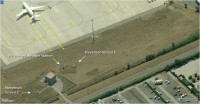
See full size view looking south here
In fact this weather station is caught between two modes of transportation. Trucking and aviation. I wonder which affects it more? I wonder if the jet parking area and the trucking staging area were always there? Here is the interactive view.
I wonder how the jet blast affects the high temperature recorded at the airport weather station on certain days when they take it out for a spin? I wonder how much the tarmac adds, or the trucking parking lot adds? Or is it all swamped by Rome’s UHI?
UPDATE: for those that might question whether jet exhaust could reach the weather stations, scroll down to see this instructional video from United Airlines done at the San Francisco airport in 1993 might be helpful in visualizing the problem. (h/t to “Just want truth")
So what are we really measuring at those weather stations at Rome’s airport?
The ENVIBASE project reports: “In the [Rome] urban area, five meteorological stations continuously collect climatic data, such as temperature, relative humidity, wind velocity and orientation, rainfall intensity, atmospheric pressure, etc., and organised them in a database form. Such stations are:
* Urbe Airport;
* Ciampino Airport;
* Rome-Eur (operating for the last three years);
* Collegio Romano (located in the historic centre of Rome and collecting data since 1782);
* Monte Mario (for a limited period of forty years).
So what we have at Rome’s Ciampino airport is in fact a climate station. I’ll have more on this and other weather stations in Italy soon. See full post and comments here.
A statement by Viv Forbes, Chairman of the Carbon Sense Coalition
The Carbon Sense Coalition today came out in support of Earth Hour, but said it should be renamed “Blackout Night” and be held outdoors, for the whole night, in mid-winter, on the shortest and coldest day of the year - 22 June in the Southern Hemisphere. The Chairman of “Carbon Sense”, Mr Viv Forbes, said that spending just one night in the cold and the dark, with no hot coffee or beef on the barbecue, using no light, heat or vehicle energy from coal, gas, petrol or diesel, and without protection from metal or concrete structures, would be good practice for the blackouts and shortages to come if world rationing of carbon products and carbon energy is achieved.
“Winter nights are usually still and cold, so the candles crew can really experience what it will be like to depend on alternative energy when there is no sun and no wind. The back-to-nature brigade can also try living without iron roofs and concrete walls. And the eat-no-meat mob can experience a night without hamburgers and cappuccinos.
“To hold a candles-and-champagne party indoors, on the mildest night of the year, for just one hour, shows that the whole thing is tokenism. Moreover both candles and champagne emit carbon dioxide. Let the true believers try the real thing in one of the extreme seasons so they can appreciate the great benefits we take for granted when using all of our carbon fuels and foods.
“Instead of sneering at human achievements they should salute the people who keep the lights on for the other 364 days of the year. Australia gets almost 90% of its electricity from hydrocarbon fuels - black coal, brown coal, gas and oil. And without the nuclear power that underpins electricity supplies in more advanced countries, the massive cuts in carbon dioxide emissions demanded by the deep greens would see Australia headed for the Romanian power rationing experience - during the Ceaucescu regime in Romania, each house was limited to ONE 25 watt bulb for all of their light.”
“All over the world we have aging power stations and an orchestrated campaign by a few warm and well-fed agitators to harass, delay and deter construction of new power facilities. Such a campaign can only have one result - blackouts and brownouts will recur erratically every time we have extremes of cold or hot weather. “So we support “Blackout Night” to prepare our population for the dark days ahead”. Read more here.
Note: As proof that this campaign is worldwide and well organized, see this press release from EPW.
U.S. Senator James Inhofe (R-Okla.), Ranking Member of the Senate Environment and Public Works Committee, today commented on the announcement that Baard Energy has decided they will no longer pursue an application with the U.S. Department of Energy’s (DOE) Loan Guarantee Program for the Ohio River Clean Fuels project (ORCF) because of litigation filed by environmental groups.
“NRDC and Sierra Club have once again successfully killed a clean coal project that would have created American jobs and strengthened America’s energy security,” Senator Inhofe said. “Groups like the Sierra Club and NRDC have mastered the art of using litigation to delay and stall projects long enough to ensure they will never proceed. Unfortunately, the greatest cost will be felt by those who are looking for good, well-paying jobs.”
Baard Energy CEO John Baardson stated in a release today, “The people of Ohio should know special interests groups are suing the State of Ohio’s EPA claiming that permits were issued to our project unreasonably and unlawfully. These disruptive activities only serve to delay the creation of thousands of jobs and hundreds of millions of dollars of investment in Ohio. The Ohio EPA spent more than a year scrutinizing these permits and even incorporated many of the comments received from the NRDC into the final permit terms and conditions. Although we are confident the Ohio EPA acted within the bounds of the law, we have decided not to pursue this financial guarantee path and are moving on toward a more reasonable strategy.”
Icecap Note: Maybe some class action suits on the part of Americans against these organizations will put a stop to this nonsense and save us from a return to the 19th century.
By Adam Voiland
During periods of peak activity sunspots, solar flares and coronal mass ejections are more common, and the sun emits slightly more energy than during periods of low activity (back images). The amount of energy that strikes Earth’s atmosphere—called total solar irradiance (TSI)—fluctuates by about 0.1 percent over the course of the sun’s 11-year cycle, even though the soft X-ray wavelengths shown in this image vary by much greater amounts.
(PhysOrg.com)—During the Maunder Minimum, a period of diminished solar activity between 1645 and 1715, sunspots were rare on the face of the sun, sometimes disappearing entirely for months to years. At the same time, Earth experienced a bitter cold period known as the “Little Ice Age.”
Were the events connected? Scientists cannot say for sure, but it’s quite likely. Slowdowns in solar activity—evidenced by reductions in sunspot numbers—are known to coincide with decreases in the amount of energy discharged by the sun. During the Little Ice Age, though, few would have thought to track total solar irradiance (TSI), the amount of solar energy striking Earth’s upper atmosphere. In fact, the scientific instrument needed to make such measurements—a spaceborne radiometer—was still three centuries into the future.
Modern scientists have several tools for studying TSI. Since the 1970s, scientists have relied upon a collection of radiometers on American and European spacecraft to keep a close eye on solar fluctuations from above the atmosphere, which intercepts much of the sun’s radiation. When NASA launches the Glory satellite this fall (no earlier than October 2009), researchers will have a more accurate instrument for measuring TSI than they’ve ever had before.
The Total Irradiance Monitor (TIM) on Glory is more sophisticated, but still related in concept to the very earliest ground-based solar radiometers, which were invented in 1838. Where those radiometers used sunlight to heat water and indicate the intensity of the sun’s brightness at the Earth’s surface, Glory’s TIM instrument will use a black-coated metallic detector to measure how much heat is produced by solar radiation as it reaches the top of the Earth’s atmosphere.
Scientists have compiled a three-decade record of total solar irradiance by patching together data from U.S. and European satellites. Fluctuations in irradiance correspond well with the cycling of sunspots. To ensure continuity, data from Glory’s TIM instrument must overlap with data from an earlier TIM (in red on this plot), which launched in 2003. Credit: Greg Kopp, LASP
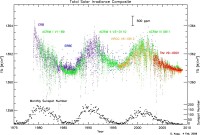
Existing measurements offer a rough sketch, but they’re not quite accurate enough over decades to centuries to paint a clear picture of whether changes in TSI reflect real changes on the sun or just artifacts of different instrument designs. That’s because the radiometers that have measured TSI so far have all reported values at slightly different levels and have all been calibrated differently, injecting a degree of uncertainty into the record.
While total solar irradiance changes by 0.1 percent, the change in the intensity of ultraviolet light varies by much larger amounts, scientists have discovered. Research shows such variations in the Sun’s emissions can affect the ozone layer and the way energy moves both vertically and horizontally through the atmosphere.
There’s a big “what if” percolating through the scientific community. The 0.1 percent variation in solar irradiance is certainly too subtle to explain all of the recent warming. “But, what if—as many assume—much longer solar cycles are also at work?” said Judith Lean. In that case, it’s not impossible that long-term patterns—proceeding over hundreds or thousands of years—could cause more severe swings in TSI. Could a modern day Maunder Minimum offset the warming influence of greenhouse gases or even throw us back into another little ice age? “It’s extremely unlikely,” said Lean, “but we won’t know for sure unless we keep up and perfect our measurements.”




